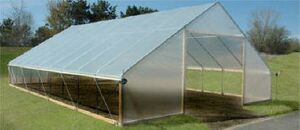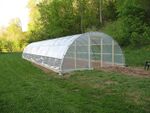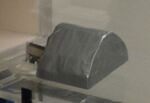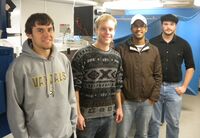High Tunnel Green House
| Sponsors | |
| Team Name | Stand Your Ground |
| Duration | Fall 2013 - Spring 2014 |
| Faculty Advisers | |
| Mentor | Jeremy Cuddihy |
| Team Members | Faisal Alahmadi
Christopher Kreps Kyle MacLean Stephen VanPatten |
The University of Idaho's high tunnel greenhouse team, Stand Your Ground, is tasked with designing a greenhouse for harsh environmental conditions. Currently there have been failures in greenhouses due to strong gusts of wind that cause structural damage and this project is to design a greenhouse to prevent such damage.
Sponsor
The University of Idaho extension program is the sponsor of this project and Tony McCammon, of the University of Idaho extension program, is the liaison for what the extension program desires for the project.
Problem Statement
Given the high wind speeds and average snow loads in the Buhl, Idaho area, the University of Idaho extension's high tunnel greenhouses have been failing. Our project is to design the ideal high tunnel greenhouse to survive the area's environmental conditions.
Interview with Tony McCammon (summarized)
- The site is located on the north west side of a pond
- The design is to be a high tunnel greenhouse with rolling up sides to allow for passive ventilation in the summer
- There has been a history of snow load damage and the end walls blowing in due to wind loads
- The project is to see if a better design for high tunnel greenhouses can be achieved for high wind speeds and snow loads
- The minimum specs are for 35 MPH sustained winds with 65 MPH gusts.
- The design team is free to redesign the greenhouse to whatever is necessary
- The plastic sheeting for the outside of the greenhouse must last a minimum of 5 years but a 10 year life span is expected if it is possible.
- The structural frame must last a minimum of 10 years.
- The orientation of the greenhouse is fixed with winds coming from the north west.
Design Goals and Specifications
- Withstand high wind speeds (minimum of 60 mph)
- Withstand snow loads of the area (20 psf according to snow maps)
- 10 year lifetime
- Door to fit a small skid-steer loader
- Roll up sides for passive air ventilation
- Must fit within a 24 x 40 area
Deliverables
- Design analysis
- Cost analysis
- Prototype
- Final Design
- Possible final model
Design Concept Development
Initial Phase
The initial phase of the design was documenting and collecting data about the site and environment. The information collected can be found under environment conditions in design data. This data concluded that the site rarely experienced wind speeds above 75 but to have a safety guideline for the greenhouse the ASCE 7-10 building code was used, requiring that the structure survive a gust of 105 mph. Using tables and equations based on the site conditions equated to a force of about 28 psf from wind loads. Using snow charts provided by the university of Idaho, the snow loads equated to be less than 20 psf on the structure.
Design Phase
The design phase was testing the idea of adding windbreaks to the end walls to prevent them from failing. The data collected during this phase can be located under the wind breaker section of the design data. It was determined that a greenhouse with a windbreaker at the ends would help insure that a large percentage of the wind would deflect off the ends and prevent them from blowing in. Using a design matrix it was determined that a Gothic style wind break would have the most benefits to achieving the clients needs. This was followed by a second wind tunnel test as well as a CFD analysis to determine how the forces would act on the structure and how much force was to be expected. Using the data generated from these tests a structure was created to pass the 105 mph wind speed requirement.
Final Phase
This phase is creating and documenting how to assemble and build the greenhouse. This process mainly involves attempting to breakdown the greenhouse and reassemble it virtually so that the client can build the greenhouse physically. The results of this phase are posted in the design documents under greenhouse instruction manual.
Design Data
Greenhouse Design Types
 Deminstration of a Gothic greenhouse style. Picture provided by Gothic Arch Greenhouses |
 Deminstration of a Quonset greenhouse style. Picture provided by Atlas Manufacturing Inc. |
The two pictures above demonstrate the two most popular design styles for greenhouses.
Environmental Conditions
Location Wind Speeds
- Latitude: 42.3900
- Longitude: -114.4439
- ASCE 7-10 Wind Speeds
- (3-sec peak gust MPH*):
- Risk Category I: 105
- Risk Category II: 115
- Risk Category III-IV: 120
- MRI** 10 Year: 76
- MRI** 25 Year: 84
- MRI** 50 Year: 90
- MRI** 100 Year: 96
- ASCE 7-05: 90
- ASCE 7-93: 70
Wind speed information is Provided by the Applied Technology Council.
It is not required in Idaho that a greenhouse meet ASCE standards but they will be used in this project as a safety guideline. The greenhouse is a risk category I building so all values of velocity will be using the 105 (mph) value.
Using ASCE 7-10 velocity pressures calculation and tables the expected wind force on the greenhouse is about 30 psf. Using the University of Idaho libraries interactive map the snow loads were found to be about 20 psf. For more a more detailed view of how this information was collected look for the file Environmental Conditions under design documents.
Wind Tunnel Test
The University of Idaho Extension office would like a high tunnel greenhouse design to withstand the extreme weather conditions in the Buhl, Idaho area. This experiment was performed to determine if a style of high tunnel end-type and wind speed plays a significant role in drag force on a high tunnel greenhouse. To perform this analysis, four models were created and tested inside of a wind tunnel at two different wind speeds, 30 and 60 mph. The models were gothic and Quonset styles with and without windbreak features. The data collected from this experiment was then used in a factorial analysis. This analysis showed that there were significant differences in drag force caused by each wind speed, model types, and their interaction. An additional ANOVA and Tukey test was conducted with the 60 mph data, due to design parameters, to determine statistically significant differences between model types. This testing showed that each type was statistically different. The two models with the least mean force were the gothic and Quonset with windbreaks. The Quonset, with a windbreaker, had the lowest mean of 4.4 N and the Gothic, with a windbreaker, had a mean of 5.9 N. The Gothic with a windbreaker was chosen for the final design due to the small practical difference between the drag force means, its ease of construction, and snow shedding abilities. For more information look at the document Wind Tunnel Report.
Wind Tunnel Test Models
Decision Matrix for Final Model
Through external research, it was found that the gothic style has better qualities for shedding snow loads. The feasibility of construction is also an important factor in design selection. These factors were then rated where a higher number meant that the design was better in a particular area than one with a lower score in the same area. The wind data generated lead to the results in the wind load section. The numbers were based off of practical differences, such as the gothic and Quonset without windbreakers were practically better than a square end but were not greatly different between each other and the windbreaker models were better than those without, but also not greatly different from each other. The weighing total was based off of what was considered important for the client, where wind load and snow sheading abilities were considered of most importance and speculated cost and ease of construction were secondary, space was of minor concern for the client. The following table, Table 6, summarizes the selection criteria for the recommended design.
The matrix shows that the research leads to the conclusion that the gothic style with a windbreak would be the most beneficial design for the client’s application. The ease of construction, snow load shedding capabilities, and the significant drag force reduction on the end walls are the main reasons for this decision. The Quonset windbreak design’s advantage of drag force reduction does not outweigh its difficulty of construction and snow shedding capability. Therefore the project will investigate the best methods to build, attach, and accommodate a gothic style high tunnel with a windbreak to meet the client’s specifications.
Second Wind Tunnel Test
After the final design model was selected, a more accurate wind tunnel model based off the developing design was created to get more accurate results. This test was not only to test head on winds but winds hitting along the flat face of the wind break. This test showed that our design, with a shorter bow, was less efficient than our original test which had a steep angled bow. The test showed that the windbreak design reduced about 30% of the force against the greenhouse whether or not it came from head on or if the wind hit its broadside.
CFD Analysis
A CFD analysis was performed on the windbreak greenhouse design to better understand the distribution of forces. The results of these tests were then used as a comparison against the flat face of a standard greenhouse. What was found was a majority of the force was concentrated at the bow of the windbreak during head on wind, as can be seen in the first picture below. When the wind was shifted to meet the broadside of the windbreak the force concentrated itself along the upper edge of the flat front of the windbreak, as can be seen in the second picture. Both these results showed a reduced amount of force along the greenhouse when compared to the flat face. Using the 105 mph wind speed as a safety guideline, the maximum force during head on wind resulted in 31.6 psf and the broad sides max was about 32 psf. The flat face of a standard greenhouse did the worst with a maximum of about 45.3 psf.
Structural Design
Using the results of the CFD analysis a frame structure was created that could withstand the 105 mph wind force. At first, welded members were used to hold the frame together but the client preferred not to have to weld the frame. This brought about the idea of using brackets and to support the frame members. The galvanized steel brackets each had an axial load rating of 2000 lb with a 2:1 safety factor. Using these brackets and the CFD results the frame structure below was developed. Using the maximum stress state it was found that the structure passed the ASCE 7-10 safety guideline imposed on the design with a safety factor in excess of 1.
Cost Analysis
After finalizing the required components and receiving a quote for the greenhouse kit, the final cost was tallied. Given a budget of $16,000 we came way under at a total cost of $5760
| Cost Analysis Overview | |
|---|---|
| Standard Greenhouse Kit (Not including shipping) | $4500 |
| Windbreaker Covering | $125 |
| Additional Steel for Windbreaker | $220 |
| Frame Fittings for Windbreaker | $500 |
| Windbreaker Extras (additional ground stands etc.) | $95 |
| Lumber | $205 |
| Concrete | $115 |
| Total | $5760 |
For more information regarding the cost of the kit and windbreaker materials, refer to the greenhouse quote under design documents.
Final Design
Using the information gathered and generated resulted in the final product shown below. Although not required for the Idaho area, the wind tunnel can withstand the ASCE 7-10 wind load requirement of 105 mph and can withstand the areas average snow load. The wind tunnel only has a windbreak on one side as the client did not wish to have a windbreak on a side that rarely receives wind. This allowed us to accommodate the opening for the skid-steer the client asked for on the non-windbreak side. This design meets all the requirements the client set down and fell well under budget. Final results can be seen below.
|
|
Stand Your Ground Team
Members
Field of Study
Job
Biographies

 Kyle MacLean
Mechanical Engineering
Sheduler/Budget Manager
I am a mechanical engineering student from Boise, Idaho. I am a resident assistant for the university this year in the second floor of the tower. I also had an internship with a nuclear power plant in Washington this summer. I enjoy intramural sports including ultimate Frisbee, kickball, and dodgeball.
Kyle MacLean
Mechanical Engineering
Sheduler/Budget Manager
I am a mechanical engineering student from Boise, Idaho. I am a resident assistant for the university this year in the second floor of the tower. I also had an internship with a nuclear power plant in Washington this summer. I enjoy intramural sports including ultimate Frisbee, kickball, and dodgeball.

 Christopher Kreps
Mechanical Engineering
Wiki Manager / Manager
I am a senior mechanical engineer of the University of Idaho and I enjoy finding easier solutions to problems and finishing lots of work while wasting little time and energy.
Christopher Kreps
Mechanical Engineering
Wiki Manager / Manager
I am a senior mechanical engineer of the University of Idaho and I enjoy finding easier solutions to problems and finishing lots of work while wasting little time and energy.
Design Documents
File:2014 GreenHouse Capstone design management timeline.pdf
File:2014 GreenHouse Meeting Minutes.pdf
File:2014 Greenhouse Enviromental Conditions.pdf
File:2014 GreenHouse Wind Tunnel Report.pdf
File:2014 HighTunnelGreenhouse Greenhousequote.pdf
Technical Presentation
File:2014 GreenHouse Technical Presentation.pdf
File:2014 GreenHouse CFD Video.ogg
Expo Poster
File:2014 GreenHouse ExpoPoster.pdf
Installation Manual
File:2014 GreenHouse Installation Manual.pdf
Design Report



















